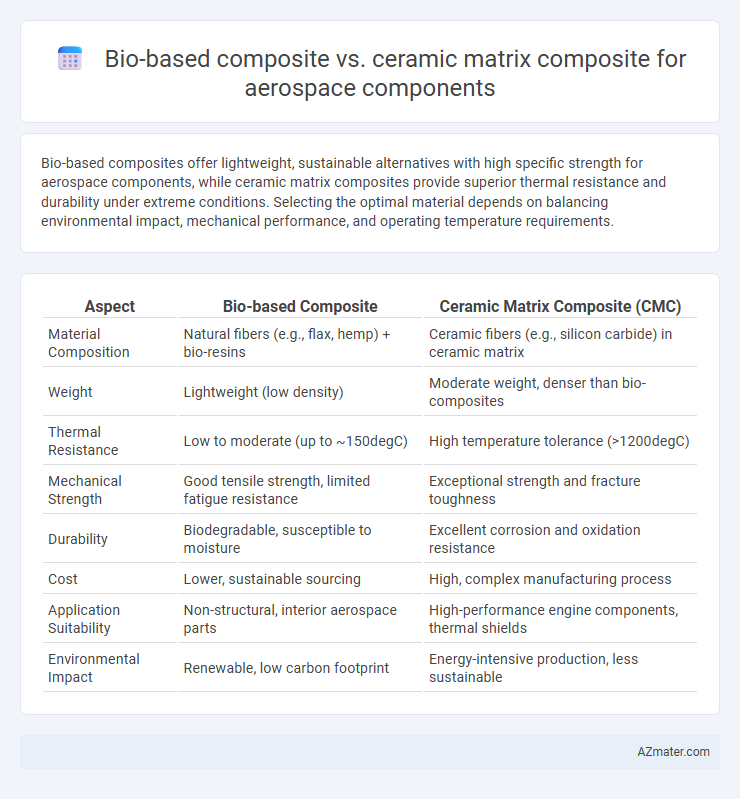Bio-based composites offer lightweight, sustainable alternatives with high specific strength for aerospace components, while ceramic matrix composites provide superior thermal resistance and durability under extreme conditions. Selecting the optimal material depends on balancing environmental impact, mechanical performance, and operating temperature requirements.
Table of Comparison
| Aspect | Bio-based Composite | Ceramic Matrix Composite (CMC) |
|---|---|---|
| Material Composition | Natural fibers (e.g., flax, hemp) + bio-resins | Ceramic fibers (e.g., silicon carbide) in ceramic matrix |
| Weight | Lightweight (low density) | Moderate weight, denser than bio-composites |
| Thermal Resistance | Low to moderate (up to ~150degC) | High temperature tolerance (>1200degC) |
| Mechanical Strength | Good tensile strength, limited fatigue resistance | Exceptional strength and fracture toughness |
| Durability | Biodegradable, susceptible to moisture | Excellent corrosion and oxidation resistance |
| Cost | Lower, sustainable sourcing | High, complex manufacturing process |
| Application Suitability | Non-structural, interior aerospace parts | High-performance engine components, thermal shields |
| Environmental Impact | Renewable, low carbon footprint | Energy-intensive production, less sustainable |
Introduction to Aerospace Composite Materials
Aerospace composite materials play a critical role in enhancing the performance and durability of aircraft components by combining lightweight properties with high strength. Bio-based composites offer renewable, environmentally friendly alternatives with good specific strength, yet they face limitations in thermal stability and moisture resistance compared to ceramic matrix composites (CMCs). CMCs provide exceptional high-temperature resistance, excellent wear characteristics, and superior mechanical properties, making them ideal for extreme aerospace environments such as turbine engines and thermal protection systems.
Overview of Bio-Based Composites
Bio-based composites in aerospace applications consist of natural fibers like flax, hemp, or jute embedded in a bio-resin matrix, offering lightweight and sustainable alternatives to conventional materials. These composites provide advantages such as reduced environmental impact, lower carbon footprint, and biodegradability while maintaining adequate mechanical properties for non-structural aerospace components. Despite challenges in high-temperature resistance and durability compared to ceramic matrix composites, bio-based composites are gaining attention for interior panels, seat structures, and secondary parts in modern aircraft design.
Understanding Ceramic Matrix Composites (CMCs)
Ceramic Matrix Composites (CMCs) are advanced materials combining ceramic fibers and ceramic matrices, designed to enhance toughness and thermal resistance beyond conventional ceramics. These composites exhibit exceptional high-temperature stability, low density, and excellent oxidation resistance, making them ideal for aerospace components subjected to extreme thermal and mechanical stress. Compared to bio-based composites, CMCs provide superior performance in high-temperature environments, crucial for turbine engines and thermal protection systems in aerospace applications.
Mechanical Properties: Bio-Based vs Ceramic Matrix
Bio-based composites demonstrate lower density and improved impact resistance, offering enhanced toughness and vibration damping suitable for lightweight aerospace components. Ceramic matrix composites (CMCs) exhibit superior high-temperature strength, wear resistance, and stiffness, making them ideal for engine parts exposed to extreme thermal conditions. While bio-based materials provide environmental benefits and flexibility, CMCs dominate in mechanical performance where thermal stability and structural integrity are critical.
Thermal Performance in Aerospace Applications
Bio-based composites offer lightweight properties and moderate thermal resistance, making them suitable for non-structural aerospace components with lower thermal demands. Ceramic matrix composites (CMCs) provide superior high-temperature stability, oxidation resistance, and thermal shock tolerance, essential for engine components and thermal protection systems in aerospace applications. CMCs outperform bio-based composites in thermal conductivity and durability under extreme heat, critical for ensuring safety and performance in high-stress aerospace environments.
Weight and Density Considerations
Bio-based composites offer significantly lower density, often around 1.2-1.5 g/cm3, making them advantageous for lightweight aerospace components aimed at reducing overall aircraft weight and improving fuel efficiency. Ceramic matrix composites (CMCs), with densities typically ranging from 2.5 to 3.2 g/cm3, provide superior high-temperature stability and mechanical strength but at a higher weight penalty compared to bio-based materials. Selecting between bio-based composites and CMCs involves balancing density-driven weight savings against the demanding thermal and mechanical performance requirements of aerospace applications.
Environmental Impact and Sustainability
Bio-based composites offer significant environmental advantages over ceramic matrix composites (CMCs) in aerospace applications due to their renewable raw materials and lower carbon footprint during production. While CMCs provide superior high-temperature performance and durability, they rely on energy-intensive manufacturing processes and non-renewable resources, resulting in greater greenhouse gas emissions. The integration of bio-based composites supports sustainability goals by promoting biodegradability and reducing reliance on fossil fuels, making them a more eco-friendly choice for lightweight aerospace components.
Manufacturing Processes and Scalability
Bio-based composites leverage renewable fibers and resins, offering lower manufacturing temperatures and faster curing cycles compared to Ceramic Matrix Composites (CMCs), which require high-temperature sintering or chemical vapor infiltration for matrix consolidation. Scalability in bio-based composites benefits from established polymer processing techniques like compression molding and resin transfer molding, enabling cost-effective mass production, whereas CMCs face challenges due to complex, time-intensive fabrication processes and the necessity of precise control over ceramic microstructures. The trade-off between the eco-friendliness and manufacturability of bio-based composites and the high-temperature stability with scalability constraints of CMCs defines their aerospace component applications.
Cost Analysis and Market Trends
Bio-based composites offer significant cost advantages over ceramic matrix composites (CMCs) due to lower raw material expenses and simpler manufacturing processes, making them attractive for lightweight aerospace components. Ceramic matrix composites dominate high-temperature and high-performance aerospace markets despite higher production costs because they provide superior thermal resistance and mechanical strength. Market trends indicate growing demand for bio-based composites driven by sustainability goals and cost efficiency, while CMCs maintain strong niche demand in engine and structural applications requiring extreme durability.
Future Prospects in Aerospace Engineering
Bio-based composites offer promising sustainability and weight reduction advantages for aerospace components, potentially enhancing fuel efficiency and reducing carbon footprints in future aircraft designs. Ceramic matrix composites provide exceptional thermal resistance and mechanical strength, making them ideal for high-temperature engine parts and hypersonic vehicle structures. Advances in material science are driving hybrid solutions that combine bio-based composites' eco-friendliness with ceramic composites' durability, pointing toward more efficient, environmentally friendly aerospace engineering innovations.

Infographic: Bio-based composite vs Ceramic matrix composite for Aerospace component
 azmater.com
azmater.com